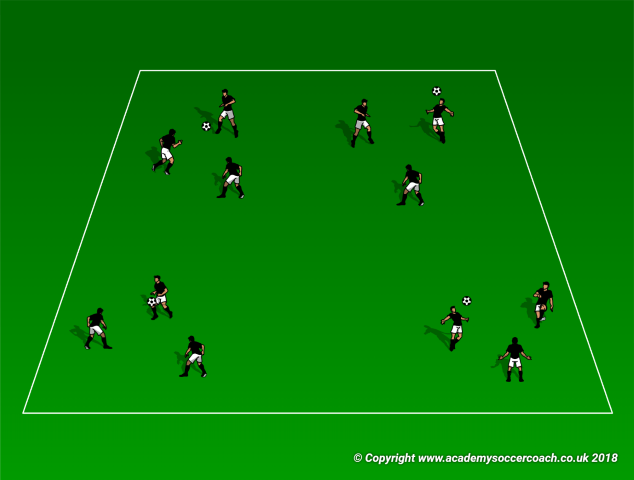WORLD CLASS COACHING
Spanish Style Possession Soccer Vol 2
By Philip Cauchi
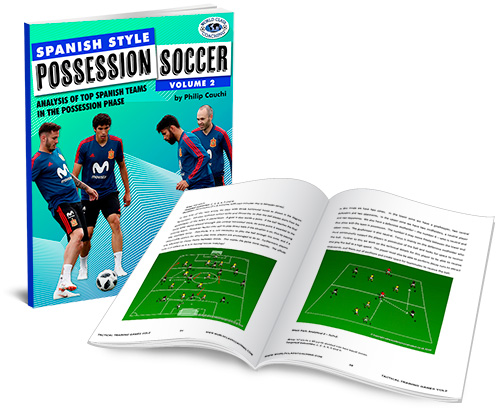
Table of Contents
PART THREE
Training Sessions
Training Sessions
Session 3
Aim: Create space and options to circulate the ball in midfield.
Outcomes:
1. Staggered positions of midfielders 6, 8 and 10.
2. Compass movement of the offensive midfielders 8 and 10.
3. Central defenders to support the midfield from behind.
4. Striker to create options to verticalize.
5. Off-the-ball movement to support the player in possession.
6. Press immediately upon losing the ball.
Total duration of session: Approximately 90 minutes.
Formation based on: 1-4-3-3.
Complexity level: Inter-sectoral (middle chain).
Equipment:
Bibs: Eight yellows and two reds.
Balls: At least eight to allow for a better session flow.
Mannequins: Four
Flat Markers: Four for analytical exercise 1.
Markers: Twenty to mark areas.
Mini goals: Two.
Description: The midfield is the engine of the team. It is therefore of upmost importance that the level of relationship with the rest of the team is high. In this session we focus on the off-the-ball movement and angles created in midfield with special emphasis given to the compass movement. The compass movement is when one of two players drops while the other either remains in the same position or moves to a higher position. Timing of passes and support to the player with the ball are two other fundamental outcomes required for the success of ball circulation in midfield in search of penetration.
Warming Up – Passing combinations.
Area: 30 yards x 15 yards.
Targeted outcomes: N/A.
Duration: 20 minutes.
We start the warm-up with activation exercises and dynamic flexibility. These are followed by the exercises described below. The warm-up ends with quick footwork and short sprints of ten to fifteen meters in length.
In variation 1 the ball-carrier dribbles to the opposite player who is situated twenty yards away. Players perform take-overs and dribbling at speed.
In variation 2, player 2 opens up at an angle to receive the pass from player 1. Player 2 then directs the ball to player 3. Players follow their pass to rotate positions.
In variation 3, player 1 wall-passes with player 2 prior to passing the ball to player 3. Again players follow their pass.
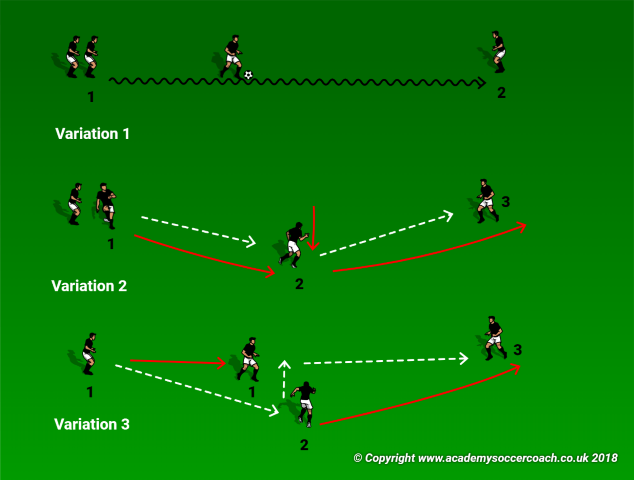
Main Part: Global Situation 1 – 5v5 + GKs.
Area: 40 yards x 30 yards.
Targeted outcomes: 1, 2, 3, 4, 5 and 6.
Duration: 10 minutes (2 x 4 minutes with two minutes rest in between series).
This is a normal fluid game where the emphasis is on developing communication in the middle sector of the team. There are not corner kicks or throw-ins. Restarts always take place from the goalkeeper of the team in possession. Even if the game is without any restrictions, we should constantly remind the players to take note of their position with respect to their teammates and opponents. In the image below we have a typical movement between midfielders 8 and 10. This is the compass movement where the 10 moves up while 8 drops diagonally behind him. This creates a possible two passing options for central defender 5. The image below shows that player 5 passed to 10 while 8 provided support by coming from a deeper position. The other midfielder 6, dropped centrally thus providing both cover and support.
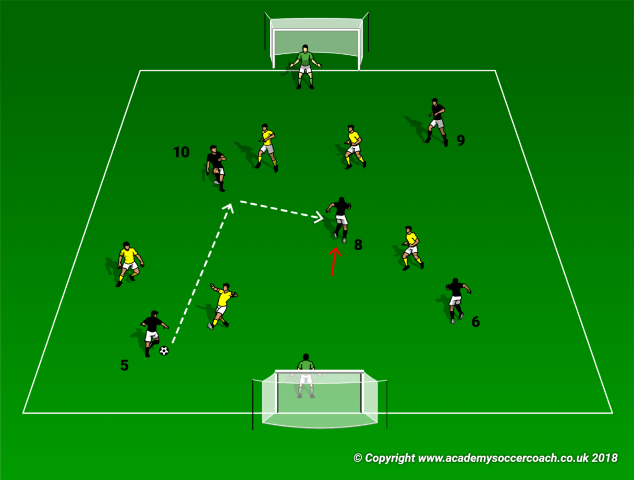
Main Part: Analytical 1 – Compass movement passing combinations.
Area: 40 yards x 30 yards.
Targeted outcomes: 1, 2 and 5.
Duration: 10 minutes (2 x 4 minutes with two minutes rest in between series).
The setup in the image below depicts a typical situation in midfield. We have the player at position 1 who could be the central defender and who passes to the player at position 3. Prior to this pass however, player at position 3 goes high while the player at position 2 goes deep (compass movement). Player at position 3 goes behind the mannequin as if to lose the defender, and then comes short to receive a pass from player 1. Player 3 lays the ball for player 2 who passes to player 4 in the space between and behind the mannequins. Player 4 plays a wall-pass with player 2 prior to dribbling the ball back to position 1. Another option would be for player 1 to play to player 2 who will then play a wall-pass with player 3 prior to passing the ball to player 4.
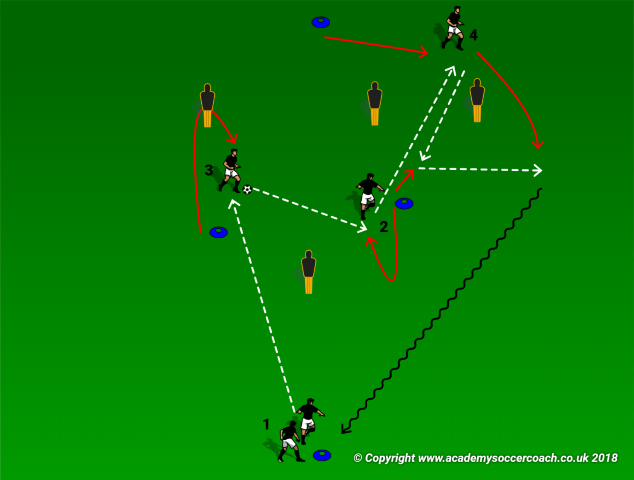
Main Part: Analytical 2 – Playing through the central zone.
Area: 65 yards x 40 yards.
Targeted outcomes: 1, 2, 3, 4 and 6.
Duration: 22 minutes (4 x 4 minutes with two minutes rest in between series).
Players practice playing in their respective positions within the team. In this training situation, both teams aim to keep possession of the ball and play to the target player – the goalkeepers. The ball must however be played through the central zone where a 3v3 plus two situation takes place. The aim of having this zone is to work on the off-the-ball movement and angles of support of the midfielders. The neutral players help the team in possession keep the ball while we work on the creation of staggered angles of the midfielders. The full backs are the only two players from both teams who can move between zones.
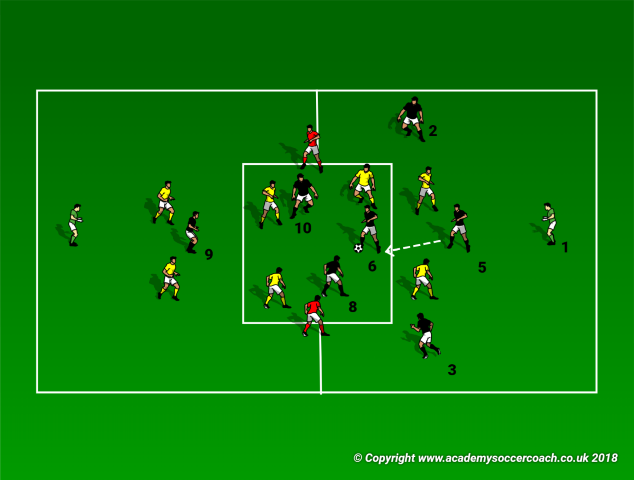
Main Part: Global Situation 2– 9v9 Match.
Area: 80 yards x 60 yards.
Targeted outcomes: 1, 2, 3, 4, 5 and 6.
Duration: 18 minutes (2 x 8 minutes with two minutes rest in between series).
Play a normal match but review with the players the key outcomes worked on during the previous activity. Work with the midfielders to support the build-up from the back and the striker to create options for the midfielders to verticalize play.
Conclusive Part – Cool down
Duration: 10 minutes.
Both teams juggle the ball and aim to score in their assigned goal which is positioned facing the opposite way. If teams drop the ball, they have to start from the beginning. End the session with static stretching exercises.
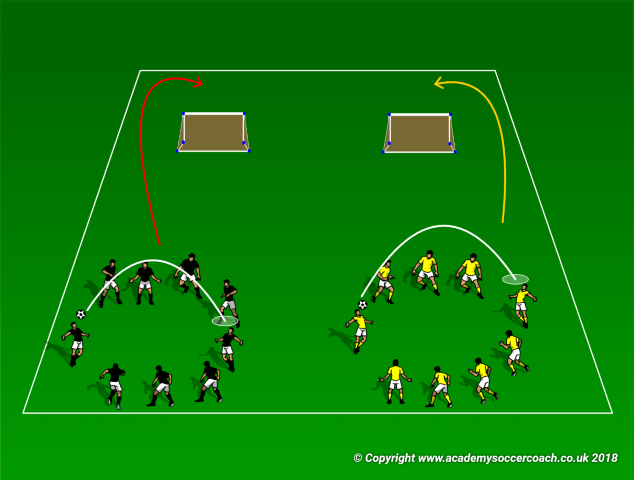
Session 4
Aim: Build-up from the back using the defensive midfielder as the low-playmaker.
Outcomes:
1. Staggered angles of support.
2. Have a safe option to play backward.
3. Create width and forward playing options using the fullbacks.
4. Build-up with three at the back – use of defensive midfielder.
5. Off-the-ball movement to create space to circulate the ball.
6. Have passing options around and in front of the ball.
Total duration of session: Approximately 90 minutes.
Formation based on: 1-4-3-3.
Complexity level: Inter-sectoral (goalkeeper, defence and midfield).
Equipment:
Bibs: Ten yellows and four reds.
Balls: At least eight to allow for a better session flow.
Markers: Twenty to mark pitch.
Mini goals: Three.
Description: We work towards developing communication between the goalkeeper, back four and midfield sectors in the creation of space in order to play vertically. Our main principle is to build from the back and with the use of constructive short passes which require focus and off-the-ball movement from the players to receive the ball in space and with various options to play. The goalkeeper plays a crucial role in this practice as he is usually the first player to initiate an attack and should always be available for the defenders to receive the ball and help them secure possession. The defensive midfielder should be the one who creates numerical superiority and more options at the back to build-up play.
Warming Up: 3v1 in two zones.
Area: 25 yards x 12 yards.
Targeted outcomes: 1, 2, 5 and 6.
Duration: 20 minutes.
Session starts with activation exercises and dynamic flexibility to increase the heart rate, blood circulation, and articular mobility and muscle flexibility. This should take approximately ten minutes. We then move on to a 3v0 three men weave, pass and overlap. The main focus being the quality of passes, passing angles, movement after passing the ball, and bearing a mentality to play forward.
Progression takes place after three minutes performing the three men weave. We now play 3v1 in each zone with play always starting from the goalkeeper. To increase mental intensity, concentration levels, as well as technique, we play with a two touch restriction. The final three minutes of the warm-up should be played as a 3v1 in the first zone and a 3v2 in the second zone. In all variations, the attacking team (blacks) aim to conclude in the mini goals, while the defending team (yellows) attack the regular goal whenever they win possession.
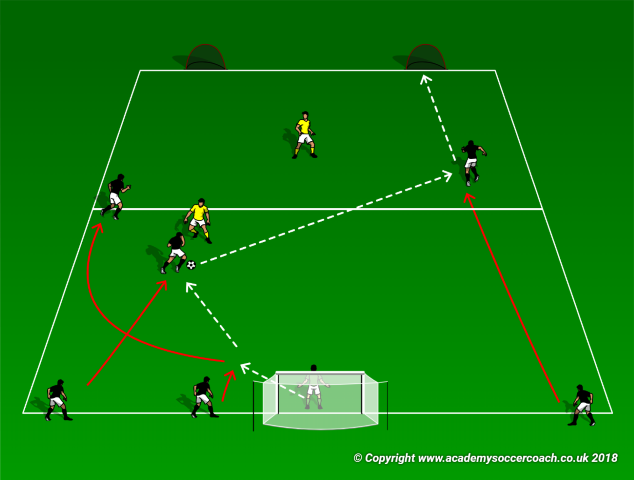
Main Part: Global Situation 1 – GK+5v5.
Area: 40 yards x 50 yards.
Targeted outcomes: 1, 2, 3, 4, 5 and 6.
Duration: 10 minutes (2 x 4 minutes with two minutes rest in between series).
We have one group playing this game while the other group performs the rondo described in analytical situation 1. After the allotted time, groups switch activities. In the below described activity we have a game with one team playing with a goalkeeper, four defenders and one midfielder (blacks) while the opponents play with three midfielders and two attackers (yellows). The focus of this activity is to create the necessary width and also depth using the two full backs (2 and 3) while having the number 6 (defensive midfielder) providing support to both central defenders and full backs. The goalkeeper plays an important role in this game as he should always provide support to the central defenders to play him the ball back whenever they are pressured. However, we need to encourage our central defenders to find the opportunity to pass the ball forward. This requires the players in front of the ball to create and move into the right spaces at the right time.
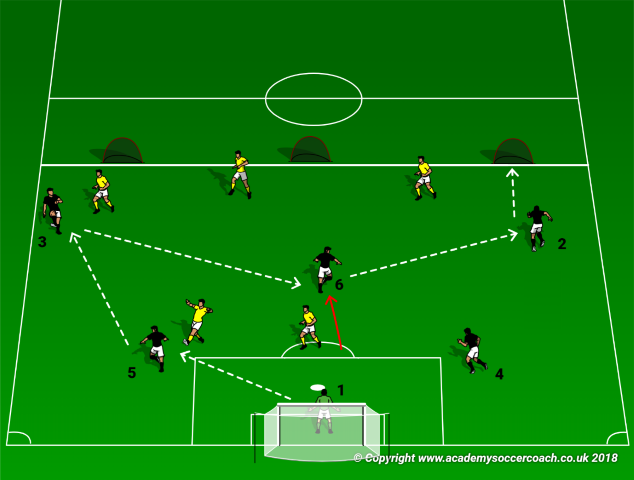
Main Part: Analytical 1 – The number six rondo.
Area: 25 yards x 15 yards divided into two equal zones.
Targeted outcomes: 1, 2, 4, 5 and 6.
Duration: 10 minutes (5 x 1 minute with one minute rest between series).
In this rondo we have two zones. In the lower zone we have a goalkeeper, two central defenders and two opponents. In the upper zone we have two midfielders, a neutral player and two opponents. We also have a defensive midfielder – the number 6 – who is neutral and thus plays with the team in possession. The number 6 may move freely between the lower and upper zones. The goalkeeper is also neutral. Focus is mainly on the defensive midfielder who must continuously support the players in possession of the ball and looks for space to receive the ball. Further to this we work on the technical details for this player to be able to receive and play the ball at a high speed. This player must also be able to perform decoy runs to attract opponents, pull them out of positions and create space for teammates to receive the ball.
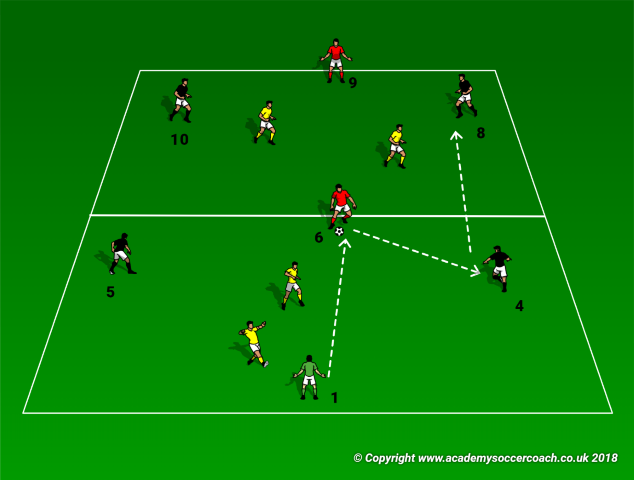
Main Part: Analytical 2 – 7v7+2.
Area: 50 yards x 40 yards divided into two equal zones.
Targeted outcomes: 1, 2, 3, 4, 5 and 6.
Duration: 20 minutes (4 x 4 minutes with one minute rest between series).
We now present the players with a situation where they have to build-up play in restricted space. In each half we have a 3v3 with players playing in their usual positions. We also have two neutral players on the flanks who provide the team in possession with a numerical advantage and thus more options to play the ball. All players are restricted to remain inside their assigned half of the pitch while the neutral flank players may move along their assigned side. Teams may only score from inside the opposing team’s half. The other remaining players play a basic rondo. These players are then rotated with other players participating in the activity just described. The major aim of this activity is to put the players in situations where they have to make the right decisions while being pressured with time and space.
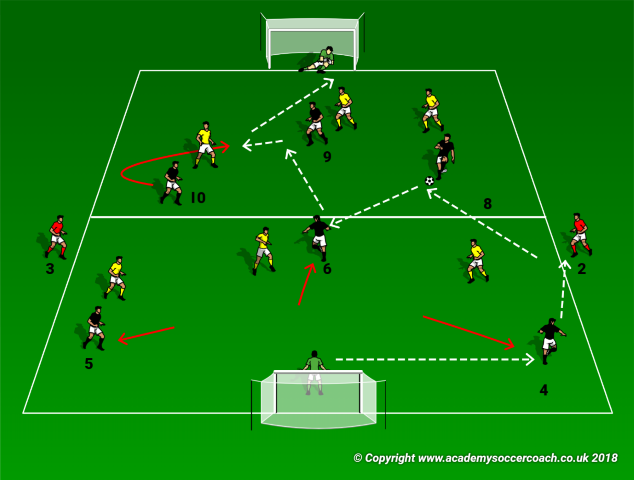
Main Part: Global Situation 2– Build-up through the thirds game.
Area: Full pitch.
Targeted outcomes: 1, 2, 3, 4, 5 and 6.
Duration: 20 minutes (2 x 9 minutes with two minutes rest in between series).
In the first of the two series we play with three horizontal zones as shown in the diagram hereunder. We play without corner kicks and throw-ins, so that the ball always starts from the goalkeeper of the team in possession. A goal is also worth a point. If the ball reaches the final third after being played through the central horizontal zone, an extra point is awarded to the scoring team. However teams may opt to play direct balls if the situation is on, thus by-passing the midfield third. Therefore, it is not necessary to play the ball through this zone, and if a favourable option for direct play exist, players are encouraged to do so. Furthermore, players are allowed to move freely between thirds. This makes the game more realistic. The offside rule is in effect as it is in normal soccer matches!
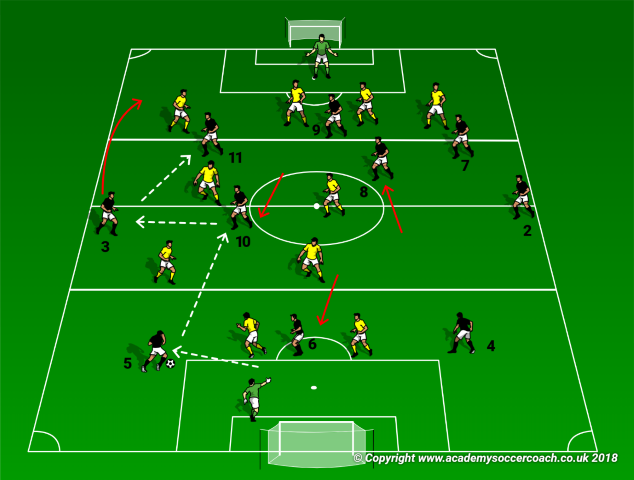
Conclusive Part – Cool down
Duration: 10 minutes.
Team is divided into groups of three or two players each. In each group players juggle the ball aiming to reach a specific number of juggles; for example twenty. As a progression each player is allowed to juggle the ball twice or even touch it only once. We can further progress this to juggle the ball using only the head or thighs and feet. The reason for giving the players a fun cool down at the end is to relax them from a mentally intensive training session. End the session with static stretching and core stability exercises.
